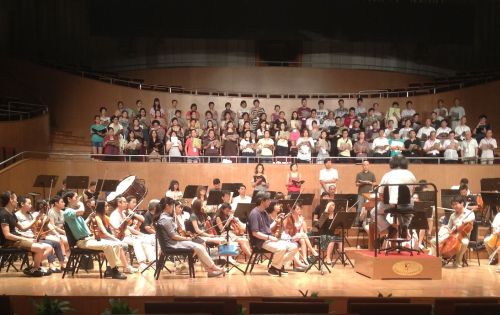 China Mendelssohn, Beethoven: Shanghai Chorus and Philharmonic Orchestra, Muhai Tang (conductor), Shanghai, China 20-7-2013 (AL)
China Mendelssohn, Beethoven: Shanghai Chorus and Philharmonic Orchestra, Muhai Tang (conductor), Shanghai, China 20-7-2013 (AL)

Mendelssohn: Concerto for piano op. 25
Beethoven : Symphony No. 9
Ju Hee Suh (piano),
Margot Didusch (Soprano),
Xuan Huang (Mezzo),
Runtao Xu (Tenor),
Maolin Zhang (Baritone)
The Shanghai Oriental Art Center is located in the Pudong district, known for its famous Pearl Tower. It hosts the city’s newest buildings and is located at the end of the prestigious Century Avenue. The hall in itself is ultra modern and hosts both a concert and an opera hall. The lobby contains many pictures of visiting artists for the upcoming season: Muti, Maazel, Gergiev, Ashkenazy … The classical music world is indeed becoming smaller. The concert hall itself benefits from superb acoustics, the orchestra being located quite centrally in the hall like the Berlin Philharmonie and can host an audience of around 1,500.
The Shanghai Philharmonic is made up of young musicians from the city’s Conservatory with the exception of a timpanist from Greece. It is a well-disciplined ensemble with some strong woodwinds. Brass can be a bit edgy but none of the works played in this concert were particularly easy. The Strings may not have the smoothness of the Vienna Philharmonic but they audibly do not have the same class of instruments at their disposal; importantly, however, they can produce a robust dynamic sound when needed.
Conductor Muhai Tang was until recently Chief Conductor of the Zurich Chamber Orchestra and has appeared several times at the Zurich Opera. He is still busy in Europe but remains faithful to his home country and leads this orchestra as well as one in Zhejiang. His wife Ju Hee Suh is from Korea. While one could have expected Mendelsohn’s first concerto to be treated as a virtuoso vehicle, as too many Chinese pianists tend to play it, it was not the case here. Her reading was both musical and measured. The music flowed unhurriedly with a steady pulse. The singing line of the Andante reminded us why this piece was favoured in his time by Rudolf Serkin, the purest of pianists.
China still reveres their young artists and in between both major works, the audience was given a treat with the appearance of a six-year old boy pianist playing a waltz by Gounod and a Chinese work with gruelling double notes, played with aplomb and gusto. The young boy was ntaurally somewhat stiff, waiting for the last applause of the audience to either return to the piano or leave the stage, but where will he be in 20 years and how many more are there like him?
There used to be a time when the idols of Chinese musicians were the German “masters”. This is not the case now, their Beethoven is clearly theirs and there are no signs of looking back to the Karajan or Furtwangler of their time. Tempi are brisker than these two and closer actually to Beethoven’s own tempi markings. Under Muhai Tang’s strong guidance, the music developed with a keen sense of line and dramatic flair while finding reflection and poise in the Adagio. The chorus was homogeneous with particular strength from the Sopranos. They have surely not performed this work often and it was heartening to see and hear them sing their heart out. The soloists were firm and well-balanced, the only European Margot Didusch displaying beautiful tone and silvery high notes; the three locals were professors at the Conservatory and displayed authority and musicality.
The near capacity audience reacted with enthusiasm. Nearly two centuries after its creation and thousands of miles away from Germany, Beethoven’s universal message of pure joy resounded enthusiastically in Modern Day China.
Antoine Leboyer